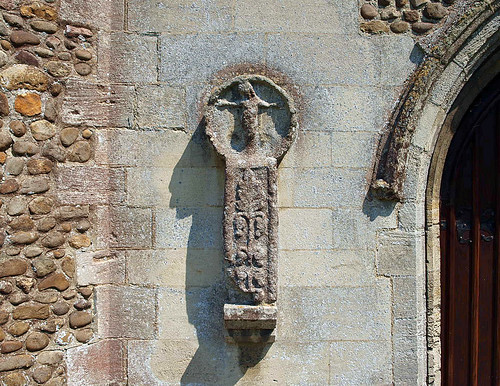ST MARY MAGDALENE. C14 W tower, the rest Perp. Brown cobbles. The arcades of four bays have typical Perp piers with capitals only to the arch openings. In the chancel a bracket on a head, in the S aisle a very pretty but mutilated vaulted niche. - SCULPTURE. Small, strange stone of keyhole shape now in the W wall of the tower. In the upper part the Crucifix, in the lower defaced foliage. - STAINED GLASS. In a chancel N window a head of Christ. - The E window by Wailes of Newcastle, 1861, the W window by Constable of Cambridge; both bad. - Also two windows by Kempe, 1896 and 1898. - PLATE. Cup and Cover Paten 1571-2; Paten on foot 1681-2. - MONUMENT. Two alabaster pieces from a tomb-chest, one with two quatrefoils enclosing shields, the other with two kneeling angels holding a shield.
HILTON. It is thrilling to find Roman brick in its church walls, made by Romans and first used by them, used again probably by the Saxons and the Normans, and again by our English builders.
The chancel arch was new about 700 years ago, the tower is a few years younger; the fine plain roofs are 15th century, as old as the font. From that great building century has also come the fragment of glass with the head of Christ in one of the windows. There is a 17th century chest. It is said that parts of the churchyard wall are 500 years old, and the’ stone cross with rich foliage and a battered Crucifixion in a circle is perhaps older still. Hilton Hall with its mellow bricks and stones has a dovecot 300 years old, and St John’s Farm goes back 500 years.
We were delighted to find in this place one of those rare survivals of Merrie England, a maze cut in the turf. It has a stone pillar in the middle on which the inscription tells us that it was made in 1660 by William Sparrow. We found two boys who showed how to reach the pillar without cheating. Often must old Robert Walpole have watched people finding their way in and finding their way out. He saw the maze made before his long life ended in the last year of the 17th century. He was 101, and had he lived a few years more would have seen three centuries; yet he had enough to boast about, for he was a child when Elizabeth was old and when Shakespeare was writing his plays; the Mayflower sailed in his youth, Charles and Cromwell were fighting in his prime, and when London was burning he still had before him another thirty years of sitting in the chimney corner talking of old times.
The chancel arch was new about 700 years ago, the tower is a few years younger; the fine plain roofs are 15th century, as old as the font. From that great building century has also come the fragment of glass with the head of Christ in one of the windows. There is a 17th century chest. It is said that parts of the churchyard wall are 500 years old, and the’ stone cross with rich foliage and a battered Crucifixion in a circle is perhaps older still. Hilton Hall with its mellow bricks and stones has a dovecot 300 years old, and St John’s Farm goes back 500 years.
We were delighted to find in this place one of those rare survivals of Merrie England, a maze cut in the turf. It has a stone pillar in the middle on which the inscription tells us that it was made in 1660 by William Sparrow. We found two boys who showed how to reach the pillar without cheating. Often must old Robert Walpole have watched people finding their way in and finding their way out. He saw the maze made before his long life ended in the last year of the 17th century. He was 101, and had he lived a few years more would have seen three centuries; yet he had enough to boast about, for he was a child when Elizabeth was old and when Shakespeare was writing his plays; the Mayflower sailed in his youth, Charles and Cromwell were fighting in his prime, and when London was burning he still had before him another thirty years of sitting in the chimney corner talking of old times.



No comments:
Post a Comment